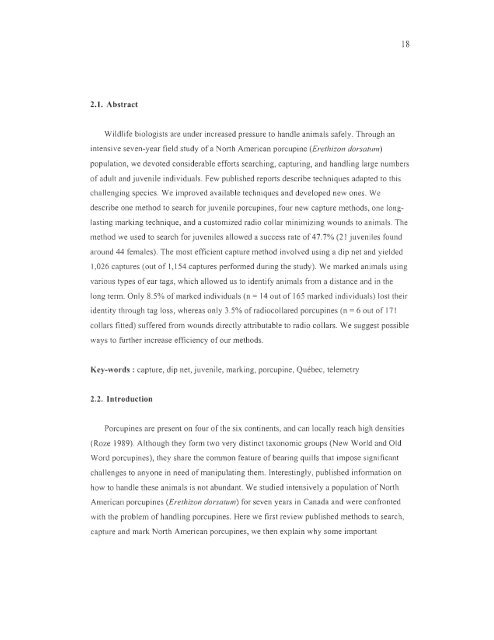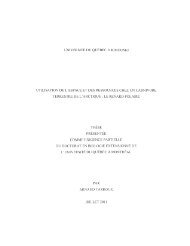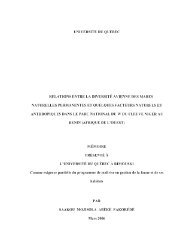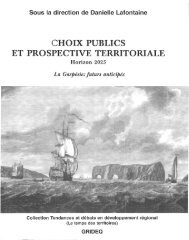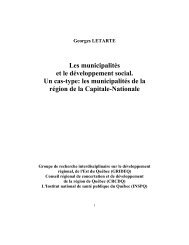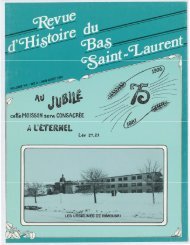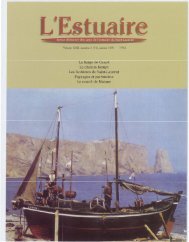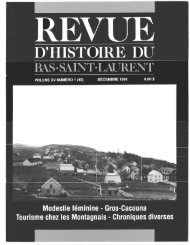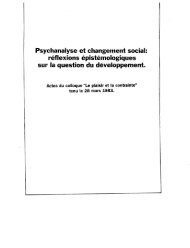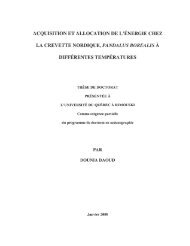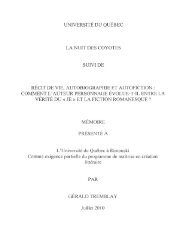influence du climat et de la prédation sur l'utilisation de l'habitat et la ...
influence du climat et de la prédation sur l'utilisation de l'habitat et la ...
influence du climat et de la prédation sur l'utilisation de l'habitat et la ...
You also want an ePaper? Increase the reach of your titles
YUMPU automatically turns print PDFs into web optimized ePapers that Google loves.
18<br />
2.1. Abstract<br />
Wildlife biologists are un<strong>de</strong>r increased pres<strong>sur</strong>e to handle animais safely. Through an<br />
intensive seven-year field study of a North American porcupine (Er<strong>et</strong>hizon dorsatum)<br />
popu<strong>la</strong>tion, we <strong>de</strong>voted consi<strong>de</strong>rable efforts sem'ching, capturing, and handling <strong>la</strong>rge numbers<br />
of a<strong>du</strong>lt and juvenile indivi<strong>du</strong>als. Few published reports <strong>de</strong>scribe techniques adapted to this<br />
challenging species. We improved avai<strong>la</strong>ble techniques and <strong>de</strong>veloped new ones. We<br />
<strong>de</strong>scribe one m<strong>et</strong>hod to sem'ch for juvenile porcupines, four new capture m<strong>et</strong>hods, one long<strong>la</strong>sting<br />
marking technique, and a customized radio col<strong>la</strong>r minimizing wounds to animaIs. The<br />
m<strong>et</strong>hod we used to sem'ch for juveniles allowed a success rate of 47.7% (21 juveniles found<br />
around 44 females). The most efficient capture m<strong>et</strong>hod involved using a dip n<strong>et</strong> and yiel<strong>de</strong>d<br />
1,026 captures (out of 1,154 captures perfOlmed <strong>du</strong>ring the study). We marked animaIs using<br />
various types of ear tags, which allowed us to i<strong>de</strong>ntify animaIs from a distance and in the<br />
long tenn. Only 8.5% ofmarked indivi<strong>du</strong>als (n = 14 out of 165 marked indivi<strong>du</strong>als) 10st their<br />
i<strong>de</strong>ntity through tag loss, whereas only 3.5% of radiocol<strong>la</strong>red porcupines (n = 6 out of 171<br />
col<strong>la</strong>rs fitted) suffered from wounds directly attributable to radio col<strong>la</strong>rs. We suggest possible<br />
ways to further increase efficiency of our m<strong>et</strong>hods.<br />
Key-words : capture, dip n<strong>et</strong>, juvenile, marking, porcupine, Québec, telem<strong>et</strong>ry<br />
2.2. Intro<strong>du</strong>ction<br />
Porcupines are present on four of the six continents, and can locally reach high <strong>de</strong>nsities<br />
(Roze 1989). A lthough they form two very distinct taxonomic groups (New World and O ld<br />
Word porcupines), they share the common feature of bearing quillS that impose significant<br />
challenges to anyone in need of manipu<strong>la</strong>ting them. lnterestingly, published infonnation on<br />
how to handle these animaIs is not abundant. We studied intensively a popu<strong>la</strong>tion of North<br />
American porcupines (Er<strong>et</strong>hizon dorsatum) for se ven years in Canada and were confronted<br />
with the problem of handling porcupines. Here we first review published m<strong>et</strong>hods to search,<br />
capture and mark NOl1h American porcupines, we th en exp<strong>la</strong>in why some important


